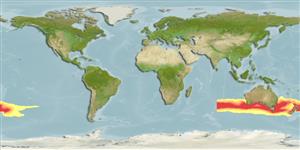Elasmobranchii (hajar och rockor) (sharks and rays) >
Carcharhiniformes (Ground sharks) >
Scyliorhinidae (Cat sharks) > Scyliorhininae
Etymology: Cephaloscyllium: cephalus, from kephale (Gr.), head, referring to its very broad and depressed head; skylion, Greek for dogfish or small shark. (See ETYFish); albipinnum: albus (L.), white; pinna (L.), fin, but used here as a neuter adjective (finned), referring to distinctive white margins on fins. (See ETYFish).
More on authors: Last, Motomura & White.
Environment: milieu / climate zone / depth range / distribution range
Ekologi
marina batypelagisk; djupintervall 126 - 554 m (Ref. 76947). Temperate
Indo-West Pacific: Southern part of Australia.
Size / Vikt / Age
Maturity: Lm ? range ? - ? cm
Max length : 101 cm TL hane/ej könsbestämd; (Ref. 76947); 102.5 cm TL (female)
Short description
Morfologi | Morfometri
A large species with the following characters: head 8.6-13.5% TL in height, trunk 16.1-23.8% TL in width; origin of first dorsal-fin usually forward of mid pelvic-fin base; prenarial 4.5-5.1% TL in length; length of preorbital snout 1.4-1.7 times prenarial length, 2.5-3.1 in prepectoral length, 6.3-6.9 in pre-pelvic length; snout-vent long, its length 48.1-52.4% TL; width of nostril 2.4-2.7% TL; eye-spiracle space wide, 1.0–1.4% TL; pectoral fin large, its height 12.6-13.6% TL, posterior margin 12.0-13.6% TL in length; anal fin tall, height 3.8–4.4% TL; anal-caudal space 4.0-5.6% SL; precaudal length 74-78% TL; interdorsal space 6.3-7.6% TL; teeth with 3-5 cusps near symphysis of upper jaw; mainly weak tricuspidate flank denticles; back without greatly enlarged denticles; long adult clasper, up to 8.8% TL, almost reaching anal fin, interspace about 4.4 in anal-fin base; vertebral centra 121-126; tooth count high, each jaw with 90-116 teeth; strong pattern of saddles and blotches on upper half of body; dark, transverse dorsal markings (9-10) on body and tail, interspaces between are narrow; interspiracular saddle subequal to eye and spiracle length; over and above gill slits with large circular blotch; fins with variably developed, narrow pale margins (Ref. 76947).
Life cycle and mating behavior
Könsmognad | Reproduktion | Lek | Ägg | Fecundity | Larver
Last, P.R., H. Motomura and W.T. White, 2008. Cephaloscyllium albipinnum sp. Nov., a new swell shark (Carcharhihiformes: Scyliorhinidae) from Southeastern Australia. In Last, P.R., White, W.T. & Pogonoski, J.J. (eds.): Descriptions of New Australian Chondrichthyans. CSIRO Marine and Atmospheric Research Paper no. 22. (Ref. 76947)
IUCN Red List Status (Ref. 130435)
Threat to humans
Harmless
Human uses
Ytterligare information
PopulärnamnsynonymerMetabolikPredatorerEkotoxikologiReproduktionKönsmognadLekSpawning aggregationFecundityÄggEgg development
Age/SizeTillväxtLength-weightLength-lengthLength-frequenciesMorfometriMorfologiLarverLarvdynamikRekryteringAbundansBRUVS
referenserVattenbrukVattenbruksprofilAvelslinjerGenetikElectrophoresesÄrftlighetSjukdomarBehandlingNutrientsMass conversion
MedarbetareBilderStamps, Coins Misc.LjudCiguateraHastighetSimsättGälytaOtolithsHjärnstorlekSyn
Verktyg
Special reports
Download XML
Internet-källor
Estimates based on models
Preferred temperature (Ref.
123201): 10.9 - 15.1, mean 12.6 °C (based on 44 cells).
Phylogenetic diversity index (Ref.
82804): PD
50 = 0.5000 [Uniqueness, from 0.5 = low to 2.0 = high].
Bayesian length-weight: a=0.00263 (0.00139 - 0.00497), b=3.21 (3.04 - 3.38), in cm total length, based on LWR estimates for this (Sub)family-body shape (Ref.
93245).
Trofisk nivå (Ref.
69278): 4.2 ±0.5 se; based on size and trophs of closest relatives
Resiliens (Ref.
120179): Låg, lägsta populationsfördubblingstid 4,5-14 år (Preliminary K or Fecundity.).
Fishing Vulnerability (Ref.
59153): High vulnerability (62 of 100).
